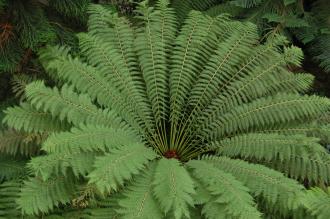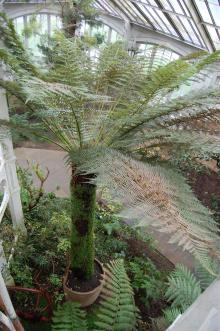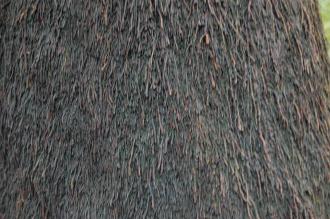
Dicksonia antarctica Leaf (18/02/2012, Kew Gardens, London)
Position: Partial to full shade
Flowering period: N/A
Soil: Moist, well drained
Eventual Height: 10m
Eventual Spread: 6m
Hardiness: 9a -11
Family: Dicksoniaceae
Dicksonia antarctica is a slow growing (1cm to 10cm per year)large evergreen fern which forms a erect ‘trunk’. Its glossy dark green leaves are fronds, deeply divided (three times), roughly textured and are up to 3m long. Its trunk is formed of erect rhizomes, the decaying remains of earlier growth and fibrous matted roots. This fern produces one sorus per lobe and are found on the underside of fertile fronds. Its roots are fibrous and found down the length of the ‘trunk’ and provide anchorage to the soil.

Dicksonia antarctica (09/02/2013, Kew Gardens, London)
Dicksonia antarctica, commonly known as Soft Tree Fern, Hardy Tree Fern, Australian Tree Fern or Tasmanian Tree Fern, is native to coastal regions of east Australia, including Tasmania. In its native habitat it grows on damp, sheltered woodland slope and occasionally in cloud forests. All tree ferns entering the UK are harvested under license and will be certificated.
The etymological root of the binomial name Dicksonia is named after James Dickson (1738 – 1822), a British nurseryman. Antarctica is derived form the Latin antarcticus meaning ‘southern’.
The landscape architect may find Dicksonia antarctica useful as a dramatic large fern. Adequate moisture needs to be provided to the whole plant to ensure the health of this fern. This fern also prefers a sheltered location.
Ecologically, Dicksonia antarctica is of little wildlife value in the UK.
The Royal Horticultural Society has given Dicksonia antarctica their prestigious Award of Garden Merit in 1993.

Dicksonia antarctica Trunk (09/02/2013, Kew Gardens, London)
Dicksonia antarctica prefers moist, humus rich, fertile, well-drained soils. It prefers an acid to neutral pH of soil. It will not tolerate dry soils.
Dicksonia antarctica requires little maintenance. Dead fronds may be removed to keep a tidy appearance.

